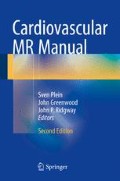Abstract
Spin echo pulse sequences exhibit intrinsic black-blood contrast, caused by the movement of blood out of the image slice between the 90° and 180° pulses, known as spin washout. In the presence of slow blood flow, the intrinsic black blood contrast of spin echo pulse sequences becomes inconsistent. Black Blood Contrast can be improved by using a black blood preparation scheme, in combination with a spin echo pulse sequence. The black blood preparation scheme consists of two 180° inversion pulses, one non-selective and one slice selective, to invert the blood magnetisation outside the image slice. As the magnetisation recovers towards zero, the inverted blood moves into the slice. The spin echo pulse sequence is applied as the inverted blood magnetisation reaches zero leading to no signal from blood. Gradient Echo pulse sequences with short repetition times commonly exhibit an intrinsic bright blood appearance from flowing blood. The short TR causes saturation of the magnetisation and a reduction in signal of stationary tissue within the slice. Flowing blood entering the slice is fully magnetised and is able to yield a higher signal than the surrounding tissue, resulting in a bright blood appearance. This effect is known as inflow enhancement and it is the main contrast mechanism employed in time-of-flight TOF MR angiography, in addition to bright blood imaging of the heart.
Access this chapter
Tax calculation will be finalised at checkout
Purchases are for personal use only
Further Reading
Balaban RS, Peters DC. Basic principles of cardiovascular magnetic resonance. In: Manning WJ, Pennell DJ, editors. Cardiovascular magnetic resonance. 2nd ed. Philadelphia: Saunders; 2010. p. 3–18.
McRobbie DW, Moore EA, Graves MJ, Prince MR. MRI from picture to proton. 2nd ed. Cambridge: Cambridge University Press; 2007a. p. 258–64. Chapter 13, Go with the flow: MR angiography.
McRobbie DW, Moore EA, Graves MJ, Prince MR. MRI from picture to proton. 2nd ed. Cambridge: Cambridge University Press; 2007b. p. 285–8. Chapter 14, A heart to heart discussion: cardiac MRI.
Ridgway JP. Cardiac magnetic resonance physics for clinicians: part I. J Cardiovasc Magn Reson. 2010;12(1):71. doi:10.1186/1532-429X-12-71.
Author information
Authors and Affiliations
Corresponding author
Editor information
Editors and Affiliations
Rights and permissions
Copyright information
© 2015 Springer International Publishing
About this chapter
Cite this chapter
Ridgway, J.P. (2015). Black Blood Versus Bright Blood Imaging. In: Plein, S., Greenwood, J., Ridgway, J. (eds) Cardiovascular MR Manual. Springer, Cham. https://doi.org/10.1007/978-3-319-20940-1_12
Download citation
DOI: https://doi.org/10.1007/978-3-319-20940-1_12
Publisher Name: Springer, Cham
Print ISBN: 978-3-319-20939-5
Online ISBN: 978-3-319-20940-1
eBook Packages: MedicineMedicine (R0)

